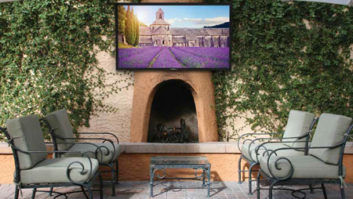
ThinkStock
Aside from the obvious goal of creating an environment that provides entertainment, excitement, and fun, the objective of designing a private theater should be to produce a room that supports the accurate reproduction of audio and video. Whether it is movie, broadcast, or game content, this accurate reproduction is vital to achieve the “willing suspension of disbelief” that transports the audience and keeps them coming back for more. It has become widely accepted that a quality private theater will include a quiet environment and balanced acoustics to bring the audio experience home. But what about the image?
Today’s projection systems are capable of delivering the highest quality and most accurate images we have seen to date. And we haven’t seen the best yet, as the promise of 4K and beyond bringing Rec. 2020 color space into the picture will compel us to conserve these pristine images at all costs. Such performance requires an environment that will be free of distracting elements, and are designed to prevent any image degradation. Elements that can be distracting and thus diminish the video experience include color, light, reflections, unnecessary details, and entries.
Distracting Elements
Color: Poor color choices within the viewer’s field of vision can cause distracting effects and should be avoided. There are a number of phenomena that can occur, but most troubling is the effect of surrounding colors on human perception of color. In short, a vivid color as the background of a screen will cause us to perceive less of that color in the screen image. So, in the case of the “classic” red theater, the risk is that viewers will perceive less red in the screen image. It is a risk not worth taking (an opposite troubling effect relating to color will be described later on).
Light: Our theater designs usually have many individual light loads. We are often asked, why so many if the room is to be dark? Multiple loads enable us to create scenes where the light source between the viewers and the screen are dimmed or nearly off to prevent any distracting element. All light sources within a theater should be out of direct view from all seating positions; even a sconce or an accent light between the viewer and the screen can cause a potential distraction, or even a degradation of the image.
Reflections: We were once presented with a high-tech screen wall design that featured a stainless steel frame and countertop around the screen. “It is brushed stainless,” we were told. Any surface that will support a mirror image off of the screen, distorted or otherwise, that is within the viewer’s field of vision, is a distraction. This can be an obvious issue like the one mentioned here, or a more subtle one like a light-colored fabric that becomes a poor quality projection screen on the side walls, particularly during bright scenes in the movie.
Unnecessary Details: Some theaters’ lavish appointments rival even those of a European palace. That may not be a problem if the details are held back sufficiently from the screen. Again, if the details are within the viewer’s field of vision they will become distracting when illuminated by bright images from the screen.
Entries: Alas, it is not always possible to place the entry at the rear of the theater; however, it should always be the first choice. We have had a few “debates” with design team members who really wanted the entry in front to preserve the “drama” of entering the theater to an impressive view of several rows of tiered seating. We sometimes have to remind the team that the purpose of the theater is for the enjoyment of movies.
Degrading Elements
Color: This is the opposite troubling effect of color mentioned before. A theater, even when darkened, has a powerful light source: the screen. When the light reflects off the screen onto vividly colored objects, colored light will reflect back onto the screen. The effect of this is a shifting of the resulting image colors.
Light: Light can also degrade the image in many potential ways. Most will recognize that illuminating the screen will reduce the black level and contrast. In fact, SMPTE requires no more than 0.16 percent of the screen luminance be from stray light. Light can also degrade the image similarly to color. If a high level of incandescent light–which is very red compared to the reference 6500K video color temperature (or worse yet, vividly colored light)—strikes the screen, the image color will be accordingly altered. Creatively developing a lighting design that supports a pleasant aesthetic while supporting pristine image quality is no easy task.
Designing private theaters that support accurate reproduction of video is no less a purposeful endeavor than that of accurate acoustical environments. It requires a process, knowledge, and cooperation by design team members. Identify early on in your design process that this is needed and why it is important. Remember, these high-powered video systems are not designed to overcome a bad environment, but to attain new levels of performance within your well-designed rooms!





